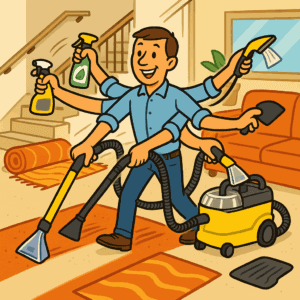Carpet Cleaner Hire in Dublin: Your Complete FAQ (Carpets, Rugs, Stairs, Sofas, Cars & More)

Thinking about hiring a carpet cleaner? Great call. Professional water extraction lifts deep dirt, oils, pollen and pet odours far better than spray-and-vac gadgets. Below is a clear, practical FAQ you can use to decide what to hire, how to use it, and what you can safely clean—at home, in apartments, and in vehicles.
A-Z Hire is Dublin’s local specialist for carpet cleaner hire (tool hire in Dublin). We supply pro-grade machines, detergents and accessories, with quick demos at collection. We’re also a Stihl Authorised dealer and service centre, so all equipment is serviced and ready to go.
FAQs
What exactly does a carpet cleaner do?
A carpet cleaner injects warm water and detergent into fibres, agitates the pile to loosen soils, and then vacuums the dirty solution back out with strong suction. Done correctly, you get deep cleaning with quick dry times.
What can I clean with a hired carpet cleaner?
- Carpets: Wool, nylon and polypropylene household carpets.
- Rugs: Many synthetic and wool rugs. (See “What should I avoid?” before tackling delicate or coloured rugs.)
- Stairs & landings: Use a stair tool/hand tool to clean treads, risers and edges.
- Sofas & armchairs: Fabric upholstery with a hand upholstery tool.
- Mattresses & headboards: Light surface refresh (avoid over-wetting).
- Car interiors: Seats, floor carpets, boot liners—ideal for family cars, taxis and vans.
- Soft furnishings: Fabric dining chairs, fabric footstools, office chairs, some curtains (only if fabric care label permits low-moisture cleaning).
What should I avoid cleaning?
- Leather, suede, nubuck. Use leather-specific products instead.
- Silk, viscose/rayon, velvet, acetate and some chenilles. High risk of water marks, distortion or dye bleed.
- Plant-fibre carpets (sisal, seagrass, jute) and foam-backed carpet tiles—water can cause shrinkage or delamination.
- Non-colourfast textiles or anything with “dry clean only” care labels. Always patch test an inconspicuous area first.
Will it remove pet odours and stains?
Yes—pair the machine with an enzyme or oxygen stain treatment before extraction. For lingering smells, clean, rinse, then run an extra vacuum-only pass to pull out moisture. Odour neutralisers help after cleaning.
How long do carpets and sofas take to dry?
Typically 2–6 hours with good ventilation and heating. Speed it up by:
- Opening windows or using gentle heat,
- Positioning an air mover (fan) across the cleaned area,
- Running a dehumidifier—especially useful in Irish weather or downstairs rooms.
What detergents do I need?
- Extraction detergent (standard or WoolSafe-approved).
- Pre-spray for heavy traffic lanes.
- Spot/stain remover (food, wine, coffee, makeup, grease).
- Defoamer is included in Karcher Products supplied by A-Z Hire in Dublin
- Avoid washing-up liquid—it leaves residue that attracts dirt.
How much solution will I use?
As a rule of thumb, a typical domestic job (3 rooms + stairs/landing) might use 20–40 L of mixed solution depending on soil level and machine size. Upholstery and car interiors use less.
What accessories should I hire with the machine?
- Upholstery/stair hand tool (a must for stairs, sofas and car seats)
- Air mover or dehumidifier for faster drying
- Stain kit (enzyme/oxyclean, rust remover if needed)
- Protective sliders/foil tabs for furniture feet
Any prep before I start?
- Clear and vacuum thoroughly. Dry soil is abrasive—remove it first.
- Pre-treat spots. Give dwell time (per label) before extraction.
- Protect furniture. Use foil tabs or sliders; lift curtains off the floor.
- Check for colourfastness and seam condition; patch test.
- Plan your exit. Start farthest from the door and work backwards.
How do I use the machine for best results?
- Fill the clean tank with warm (not boiling) water and the correct detergent dose.
- Pre-spray heavy areas, agitate with a soft brush.
- Slow wet pass: Trigger on, move steadily forward.
- Slow dry pass: Trigger off, pull back slowly to extract.
- Do an extra vacuum-only pass on each lane to speed drying.
- Rinse pass (clean water only) if residue or stickiness is a concern.
- Groom the pile with a carpet rake. Ventilate and dry.
Tips for stairs, sofas and cars
- Stairs: Work top-down with the hand tool; keep hoses tidy along the skirting.
- Sofas: Light overlapping passes, minimal moisture; cushions upright to dry.
- Cars & vans: Remove mats, pre-spray seats and footwells, use short, controlled passes to avoid soaking foam.
Power and water requirements?
- Standard 230 V / 13 A socket (avoid multi-gang overloads).
- Use warm water (40–50 °C). Hotter isn’t better and can set stains or damage fibres.
- An RCD-protected extension lead can be used.
Common mistakes to avoid
- Over-wetting (slow dry passes prevent wicking and browning).
- Too much detergent (causes rapid resoiling).
- Skipping the vacuum stage.
- Ignoring foam in the waste tank—use defoamer.
- Cleaning “dry clean only” fabrics.
Troubleshooting
- Poor suction? Empty the waste tank, check gaskets/lids, look for blockages in the wand or hose.
- No spray? Re-seat the solution tank, check filters, straighten kinks, prime by holding the trigger for 20–30 s.
- Excess foam? Add defoamer to the waste tank, not the clean tank.
- Musty smell after cleaning? Increase airflow, do an extra vacuum-only pass, and consider an odour neutraliser.
Can I use this after a leak or minor flood?
You can extract and clean fresh, clean water spills. For larger escapes or any dirty/black water, you’ll need wet vacs, dehumidifiers and air movers plus sanitising—ask us for the correct setup.
What about end-of-tenancy or preparing a property for sale?
A deep clean lifts traffic lanes and odours, helping with deposit returns and viewings. Keep your hire receipt and take before/after photos.

